When looking at the best type of intermittent fasting, you will find many articles. But they often seem to only scratch the surface, giving you guidelines, but not much science or insights on it. Based on studies, my own experience, and the one my friends shared with me, what would be the best type of intermittent fasting?
The best type of intermittent fasting is the one that suits your lifestyle and goals. If you are aiming for fast weight loss, try one meal a day or alternate-day fasting. If you’re looking to get thinner and healthier in the long term, 16:8 intermittent fasting is the best compromise. But it is important to experiment to find what suits you best.
I’ll talk in-depth about the different types of intermittent fasting, but I’ll also talk about prolonged fasts, my take on it and why you should definitely consider them.
Daily fasts
Meal Skipping
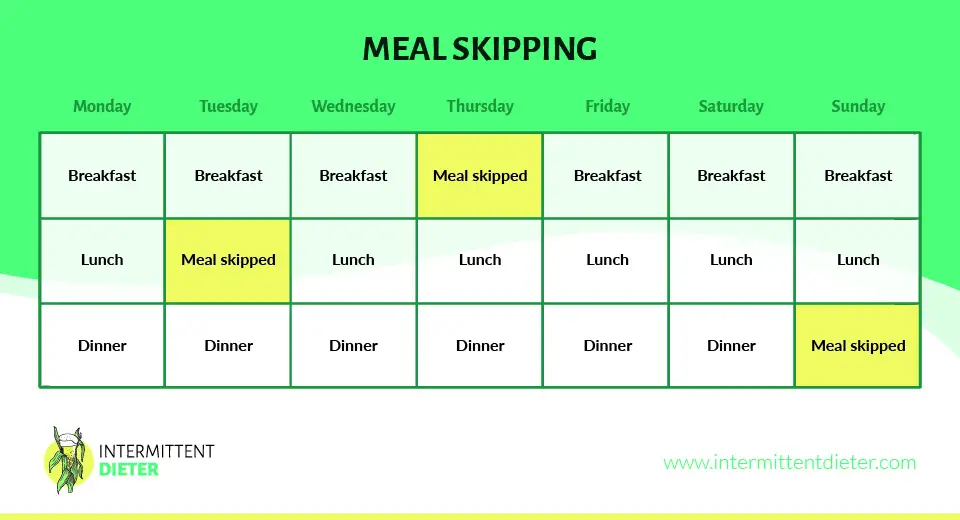
This is often mentioned as the first step to intermittent fasting: randomly skipping meals.
Humans are creatures of habit and once you experience intermittent fasting, you’ll realize being hungry at noon is simply your body telling you that you usually eat at noon.
You’re not actually hungry and once you’ve gone past the initial hunger, you’ll discover you can skip the meal quite easily.
So, if you want to start implementing intermittent fasting, it’s often advised to start by randomly skipping meals. That’s not exactly a “diet” or a “type of intermittent fasting” by any means because you’re not making it a habit.
You simply felt that you could skip breakfast, lunch or dinner on any given day because you didn’t feel that hungry. And you can, and that can empower you with the idea that meal skipping is not that hard.
Eating three times a day is not an absolute necessity, you won’t suddenly collapse and you’ll discover you can still feel great without your sandwich and salad at lunch.
That’s a great first step at putting some barriers down, the infamous “I could never do it” little voice in your head. But I would consider that a step into convincing yourself you can fast, not the first step into intermittent fasting.
You see, intermittent fasting is all about habits building and restricting your eating window. Simply skipping a meal now and then doesn’t take into account what and when you ate before, how long you went without eating, etc.
If you want to try any type of fast, you can definitely start by randomly skipping meals, to convince you it’s not an impossible task and that “even you” can do it.
But once this psychological border is crossed, you should start implementing the real thing.
As for studies on the subject, there are many on meal skipping as a habit (especially breakfast) or any other type of eating disorder, but none has been done on the “diet” effects of randomly skipping meals.
12 Hours Fast (12:12)
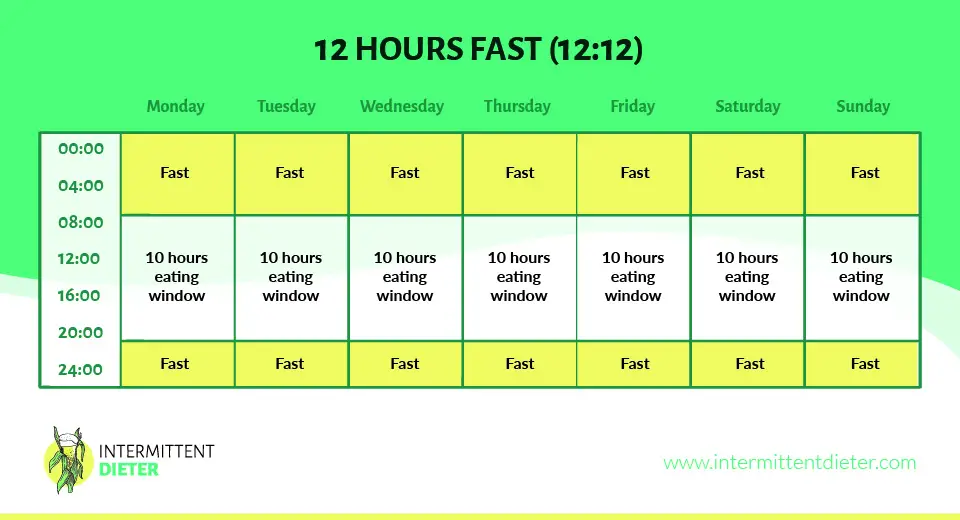
12 hours fast would be the real first step into intermittent fasting. And that’s what I advise people to do when talking about intermittent fasting.
The easiest way to implement this is simply to skip breakfast and do not get any type of calorie between when you last had some in the evening and when you eat again 12 hours after.
Let’s say you go to bed at 11 pm, you finished your tea with some sugar (yes, I’m counting this) at around 9 pm. So, you shouldn’t eat before 9 pm the next day.
That seems easy enough, doesn’t it? You might actually say “I already do that!” and that’s fine. But I would advise you to make sure you really do it.
I’m saying 12 hours without any calorie: no orange juice, no sugar, cream or milk in your coffee, nothing, zero.
I often have people say, when I’m talking about intermittent fasting, that they already skip breakfast, therefore they are fasting. Fasting is not about not eating, it’s about not getting any caloric intake in your body.
So, for 12 hours, you’ll be drinking sugarless, creamless, milkless tea or coffee and water. That’s it. Make sure you get a habit of doing that before fasting for longer periods.
And you know what? Even if on the first days you’re craving for food after 10 or 11 hours fast, don’t sweat it, eat something. Just try holding it a bit longer the next day.
Implementing intermittent fasting is not a race or a competition, you can go all in, but it’ll be hard. You can also make it really smooth and easy. You’ll see that in a few days you’ll be able to do it and build a habit out of it quite easily.
That, my friend, is the first step into intermittent fasting.
Like skipping meals, 12 hours fast has not been subject to many studies.
It’s often used as a comparison against longer fast, such as in this study about eating habits, where they compared 9 hours, 12 hours and 15 hours fasts effects on mice.
If this first step is enough for you and has the desired effects, that’s perfectly fine and that’ll make you a 12:12 intermittent faster!
But once you’ve reached 12 hours fast, if you think the results are not relevant enough, go a bit further. Say, 4 hours further?
16 Hours Fast (16:8/14:10)
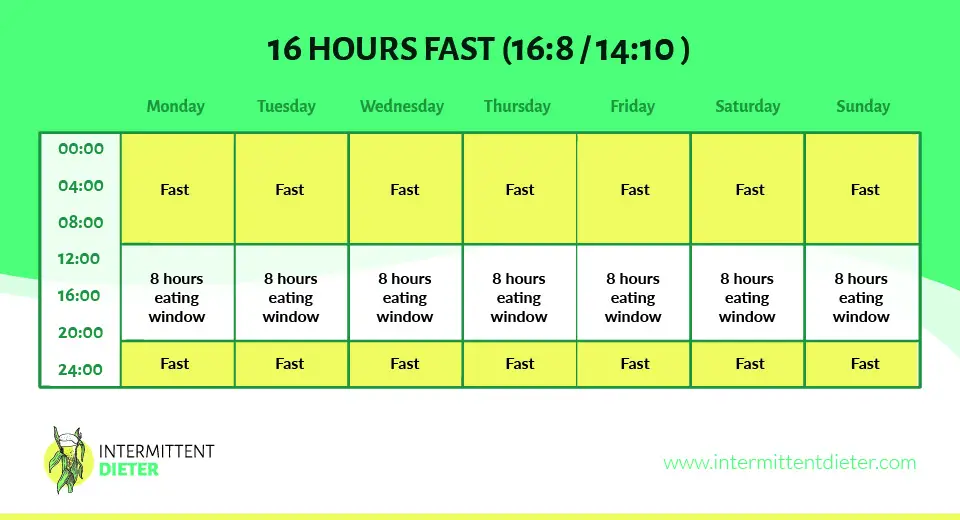
This is I think the most popular way to do intermittent fasting. This means you don’t get any calorie intake for 16 hours long during the day, reducing your eating window to 8 hours.
If you ate your last calorie at 8 pm in the evening, you won’t get any calorie until 12 pm the next day. That’s a lot like skipping breakfast and it is mostly an improvement on the 12 hours fast.
As you might have seen in the title, there’s a 16:8 method and a 14:10 method. I’ve read many times that men should do 16:8 intermittent fasting and woman 14:10, meaning 14 hours fast.
Like in many other diets, men and women might react differently to it, and so the diet is adapted. But I have to say I had trouble finding any real evidence suggesting that women should fast for a shorter time.
The only thing I found, is that women are more subject to cravings and doing 14:10 might be easier while still getting results. The craving thing is not because women have less willpower than men, but because, to quote this study :
Furthermore, for women, there are sex hormone-related variations in craving and food cue reactivity that may hinder dieting and weight loss attempts.
And hormone plays a huge role in the body and on weight loss of course. Might I remind you that weight regulation is a hormonal thing? (hey insulin, didn’t see you there)
I’m not one to argue with science, but my girlfriends have never had much more difficulties than me to follow intermittent fasting in any way. And I have way more women friends who tried implementing it successfully than men.
But as I mentioned before in the 12 hours fast, 14 hours, 16 hours or whatever: what’s important is that you should have a goal. You take all the time you need, a week, a month, to reach it and then, you’re free to do what you want with it.
That’s what’s so great about fasting, you’ll be counting the hours at first, but after a while, it’ll come naturally. You might even end up doing 18 hours or 20 hours fast depending on how you ate the night before or how late you eat lunch.
I’m always talking about skipping breakfast, but that’s not an obligation. It’s just the easiest meal to skip in my opinion.
But if it’s easier for you to skip dinner or lunch, do it. Intermittent fasting is flexible, you can adapt it to your lifestyle and habits.
As for the results, you would get with this type of IF, it depends on your condition, eating habits, etc. But you’ll definitely lose weight. At first, you’ll even lose quite a lot quickly. I lost around 10 pounds in a month when I first started.
In this study, restricting your eating window to 8 hours (doing 16:8) showed an average of 2.6% weight loss in twelve weeks across 23 obese subjects, amongst other effects (reduced blood pressure and triglycerides).
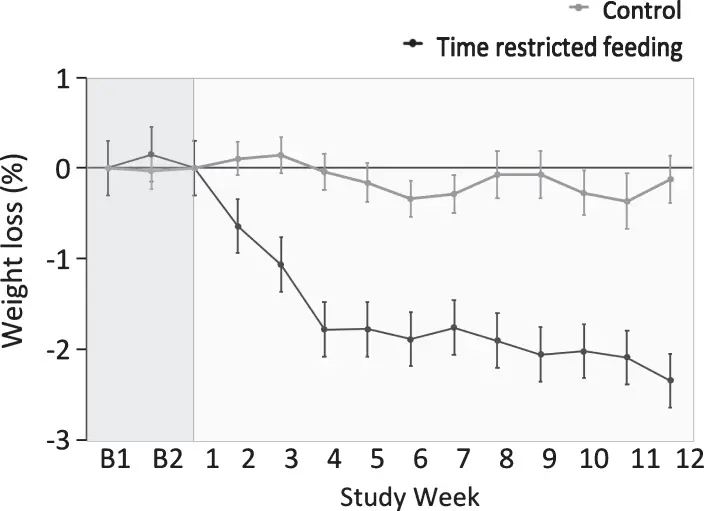
This other study on 16:8 IF conducted for 8 weeks on resistance-trained males showed a reduced fat mass (around 1.5 kg), improved health-related biomarkers and maintained lean body mass (muscles).
A review study compared continuous caloric restriction to intermittent fasting and specifically 16:8 / 14:10 IF on overweight and obese patients. The studies reviewed had to be at least 8 weeks long.
What they discovered among other things is that both diets basically were as efficient for weight loss. Which is great, because counting calories is a pain, a form of starvation, and will hardly be sustainable and efficient in the long term.
While IF is easier to implement and follow and keeping the weight down will be easy since it’ll boost your metabolism. On the contrary, calory restriction will slow it down.
Bulletproof Intermittent Fasting
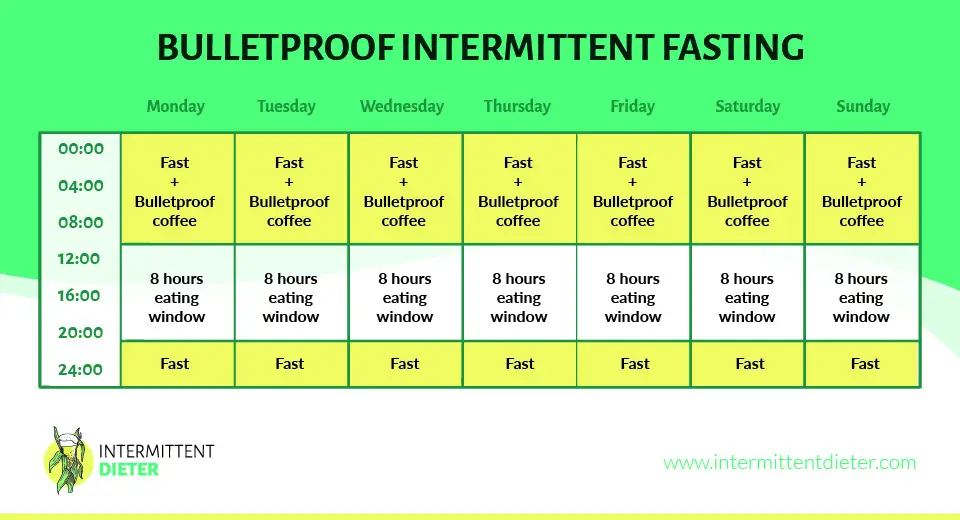
This is by no means an “official type of intermittent fasting”, but I’ve seen it mentioned a few times and, without knowing it, I did bulletproof IF for a while and still occasionally do it.
This type of fasting means you’ll be getting a bulletproof coffee (or tea) during your fasting period. To bulletproof a coffee, simply add some good fat in it (generally MCT oil).
If you want to know more about bulletproof coffee, its benefits, what it does to your body and the complete recipe, check out my full article on the subject.
The goal of drinking bulletproof coffee when intermittent fasting is:
- To help you feel more satiated without getting out of ketosis
- To improve focus and energy
- To help you through the water, coffee, tea routine of fasting with a delicious foamy coffee
When you’re fasting for a long enough period, most of the energy stored in your body (in your glycogen stores), will be depleted. Once it’s done, your body will have no choice but to turn to your fat stores for energy.
What it’ll do is break down fatty acids and fat-cells for energy, during this process, some of the cells will be turned into ketone bodies. Ketone bodies are the preferred source of energy for the brain.
MCT oil, which is generally added to bulletproof coffee, is rich in ketone bodies. And fat alone won’t raise insulin levels and kick you out of ketosis.
This means drinking bulletproof coffee won’t prevent the weight loss effects of fasting, at least not too much in the long term.
While you’ll stay in ketosis if you drink bulletproof coffee and it might help you feel more satiated without eating, you won’t benefit from other effects of fasting like autophagy (the “detox” effect), since it might prevent it.
Bulletproof intermittent fasting often goes along with some kind of ketogenic diet you’d follow, since it’ll provide a big amount of good fat, which is important when doing keto, and it’ll help you get into ketosis faster.
I would advise bulletproof coffee as a “meal” when doing one meal a day. You replace lunch with your bulletproof coffee and you might actually feel satiated all afternoon.
It can also be used to help get through a shorter fasting period at first. My only problem with bulletproof coffee is that if you want to do IF for weight loss, you shouldn’t rely too much on it.
Believe me, after I knew it broke a fast and didn’t have that many benefits when doing 16:8 with a normal diet, I still do it randomly because it tastes so good.
So don’t get hooked on it, simply use it as a tool to help you with intermittent fasting if you’re not under any other diet.
If you’re doing keto though, that’s definitely a great addition!
The Warrior Diet (20:4)
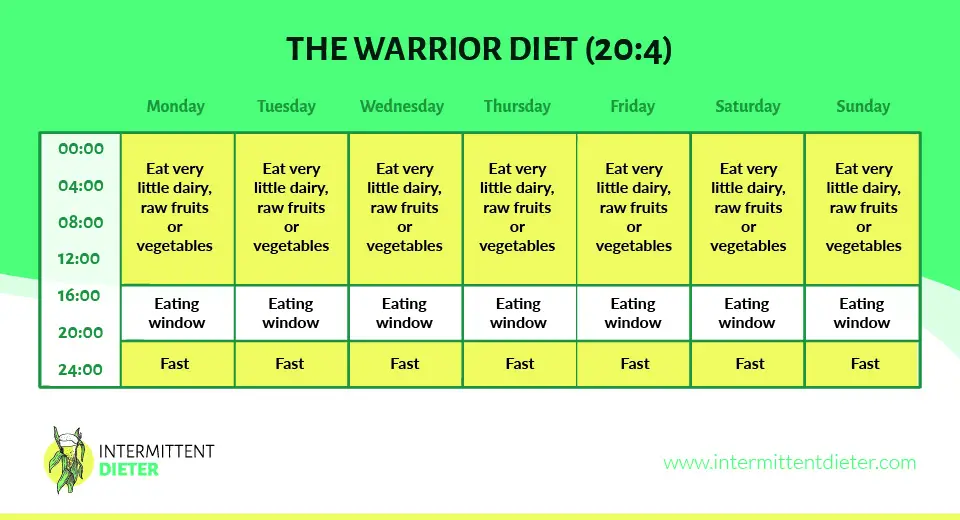
The Warrior Diet is loosely connected to intermittent fasting because it imposes a 20 hours kind-of-fasting period. You don’t have to fast, but you should eat very little.
The idea is to eat very few calories during the 20 hours window (some dairy products, raw vegetables and fruits, hard-boiled eggs) and then eat anything you want at night.
This diet was created by Ori Hofmekler, a former member of the Israeli Special Forces. He doesn’t claim it to be based on any actual science, it’s more based on Hofmekler beliefs and observations.
The goal of the diet is to follow the same eating patterns as our warriors’ ancestors, which would eat very lightly (berries and stuff) during the day and feast at night.

Depending on how you might do the warrior diet, you won’t be doing any actual fasting.
When you’re fasting, other side-effects will trigger in the body, like autophagy, more focus, more energy in the long term, etc. Some of these benefits might not be alleviated when doing the warrior diet.
Eating small amounts during the day might get harder than not eating anything. When you eat anything, your body will consider you’re in your eating window, your digestive system will get to work and certain hormones will be produced.
Fasting gives your digestive system a rest and the physiological effects of not eating anything will mean less hunger or craving between mealtimes. I’m not sure a Warrior Diet would be that easy and effective.
There’s one more thing I’m not a huge fan of in this diet: the fact that you would eat during the night.
I mentioned this in my article on intermittent fasting, keto, and energy, but it seems that increased insulin in the body will downregulate levels of melatonin and vice versa.
Melatonin is the sleep-promoting hormone, so that means that getting to sleep will be easier with low levels of insulin in the body. That means that feasting at night might also disturb your sleep and circadian rhythms.
I’m not saying you won’t lose weight or get any benefits from the Warrior Diet, to me, it feels more difficult to follow than 16:8 or one meal a day.
While there are certainly some benefits to it (weight loss, metabolic health, etc.), I couldn’t find any study specifically on the warrior diet and how it compared to actual fasting for health and weight loss.
24 Hours Fast (One Meal A Day – OMAD)
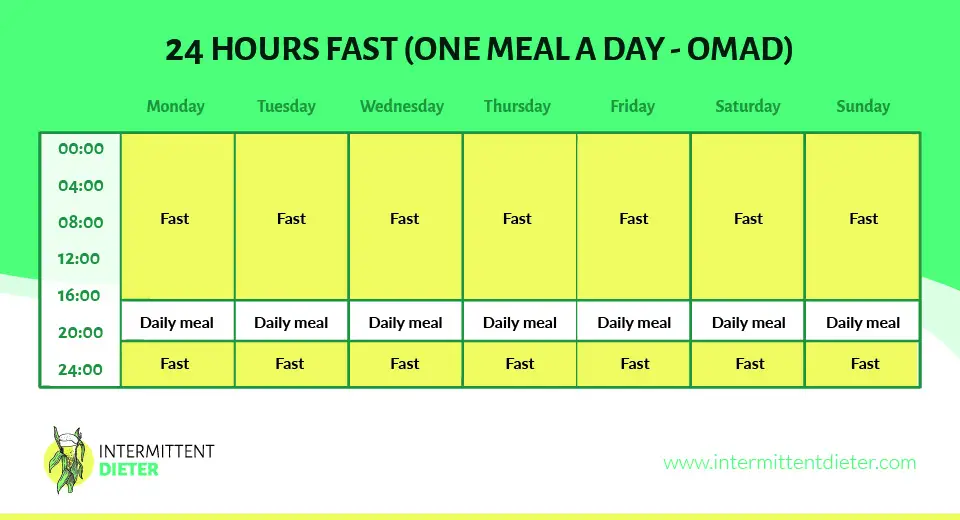
Basically, you only eat once a day, at breakfast, lunch or dinner.
There isn’t much evidence on which meal to favor in order to promote health or weight loss. For me, the easiest way to do it is to skip breakfast and lunch.
I usually don’t eat breakfast when doing 16:8 because it’s easier (since sleeping only will already account for around 8 hours fasting), cutting lunch simply is the next step.
And since for most people dinner is the only meal they’ll take time to eat with their family, it makes sense to put emphasis on this one.
Now, once you broke your fast, your eating window will depend on how long it takes you to eat your meal. That definitely shouldn’t be stressed, you should take your time and savor it. You shouldn’t care about your eating window at this time!
And you’ll also discover that you really won’t be eating that much, no matter how hungry you are.
This study was conducted in order to see the impact of one meal a day on glucose regulations on healthy patients. The control group ate 3 meals a day and the study group the equivalent of the 3 meals in one large meal.
Here’s an excerpt of their findings:
Our findings show that consumption of one unusually large meal per day worsens morning glucose tolerance compared to an isocaloric diet spread across three meals. However, when on 1 meal/d the subjects would have eaten less than those on 3 meals/day if we had not asked them to consume the same amount of food that they normally eat on a 3 meal/d schedule.
Source
They go on to say that when rodents are submitted to these types of eating patterns they ended up getting around 10 to 30% less caloric intake.
From experience, I can safely say that you might even eat less during your one meal than you would have normally eaten on this very same meal. Meaning you could get around 70% fewer calories in a day.
What’s absolutely sure is that you won’t be able to eat as much in one meal as you would have in three, unless forced to eat as much!
Even if you get crazy every day and eat a big meal, this study found that you’ll still lose some weight while not impacting your overall health.
There are other benefits to eating once a day, like feeling energized in the afternoon since your body won’t need to digest the food you ate.
At first, one meal a day could have a negative impact on your overall energy though. When I started doing it, I always had a kind of energy drop around 4-5 pm. That could come from low blood sugar.
But after a few days, it totally disappeared and I started feeling energized throughout the day. If you want to know more about energy and fasting, check out my full article.
So if 16:8 is not effective enough for weight loss or if you’ve reached a plateau, one meal a day is a great improvement on that.
Not only will you lose weight, just check all these testimonials on the web, but one meal a day will definitely reduce cravings and make you less hungry in the long term.
Even if you go back to 16:8 or three meals a day, you’ll see that you’ll have reduced your appetite if you did one meal a day for a while.
Weekly fast
Alternate Day Fast (1:1 or 4:3)

This might be the most well-documented type of intermittent fasting you can do.
Most of it has been conducted by Dr. Krista Varady. She’s an assistant professor of nutrition with the University of Illinois in Chicago and author of The Every Other Day Diet.
Following the diet, you’ll be fasting one day and eating normally the next day. There are actually many variations on this idea, most of them allow consumption of up to 500 calories during fasting days, so it’s not strict fasting.
You shouldn’t be getting the 500 calories through snacking during the day, of course, I’d advise you to keep any caloric intake to one meal, this way you still alleviate the great effects of fasting by restricting your eating windows.
When it comes to science, you’ll see if you’ve read some study on fasting that Alternate Day Fast (ADF) is often the type of intermittent fasting used in studies.
ADF might seem hard, but many people experiencing with calorie restriction diets said that it was actually a lot easier to follow. This study, for example, talks about how obese subjects adapted very quickly to ADF.
Regarding weight loss, ADF seems to be very effective, this study showed between 4.3 to 6.1 kg lost in 12 weeks, with no reduction in lean mass.
This other study showed reduced markers of oxidative stress and inflammation in overweight people, with significant weight loss during the 8 weeks experiment. Up to 8% less body fat as you can see.
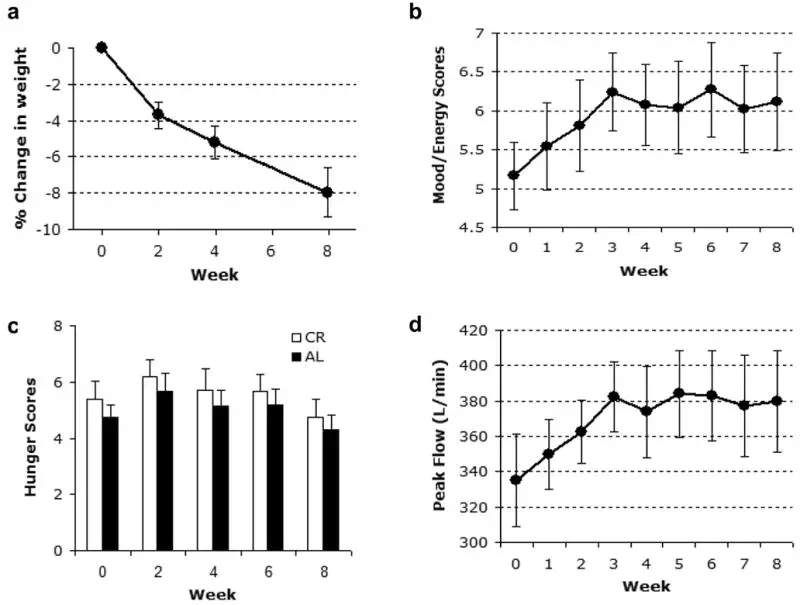
All that while reducing hunger and improving overall mood and energy. Not bad!
To summarize, ADF seems to be easier, more effective for weight loss while still preserving muscles, than other calorie restriction diets. Check out this systematic review on the subject.
Now is it easy to follow when compared to other intermittent fasting types? To be honest, I never tried ADF. The problem I would see with it is the lack of consistency, one a day to day basis.
With regular fasting, every day is pretty much the same, you’re going to fast for a given time and eat around specific times. If you want to try ADF, you should already be familiar with 16:8 or OMAD, to make things easier.
But I’ve read testimonies of people saying that after a few days, they realized they weren’t really hungry on the fasting day but far more the next.
The body adapts. Again, it’s a machine of habits and once the habit has been built, it’ll become easier.
Fast Diet (5:2)

The Fast Diet has been popularized by journalist Michael Mosley, author of the book The Fast Diet.
The concept is easy enough, each week, you will be eating normally five days and fasting for two days. You can pick any day to be a fasting day, as long as there is a normal day in-between.
Like the alternate day fast, the fast diet doesn’t require you to do strict water fasting during your fasting days. You’ll be able to eat up to 500 calories for women and 600 calories for men.
Generally, it’s preferred to fast on Monday and Wednesday, or Thursday. I would keep the fasting day as far from the weekend as possible, to keep it from impacting your social life.
Think of the Fast Diet as a lighter version of the Alternate Day Fast. It quite clearly compares, since ADF is 4:3 and the Fast Diet is 5:2. It should simply be easier to follow, especially because you won’t have to do it on weekends.
I would argue that it’s what clearly makes this diet easier to follow, being able to do it only during weekdays. While ADF really has this neverending feeling.
But when compared to ADF, it might be a bit harder to make a habit out of the Fast Diet, since you’ll be able to move days around. Essentially, the fasting days may be harder to go through since they’re not as consistent.
I’ve found very few studies specifically on the 5:2 diet sadly. But if you think of it as a light ADF, most of the studies conducted on the 4:3 Diet would also be true, with lesser effects, with the 5:2.
There’s this study on intermittent fasting, where they mentioned the 5:2 as a “Modified fasting regiment”. It took a look at the effects of intermittent fasting on metabolic health.
They looked at how it affects circadian rhythm, how it reduces risks of obesity and cardiovascular diseases and concluding that any type of intermittent fasting will account for some weight loss.
Like ADF, I’m not a huge fan of non-strict fasting days. You could experiment with it, but I would argue not eating for a whole day might actually be easier than counting calories and eating small meals that could leave you pretty hungry.
One of the great appeals of these kinds of diet is that you can eat anything you want on other days.
Meaning eating three times a day and snacking whenever you want. If you follow the diet you shouldn’t get more than your daily caloric needs (around 2’000 for women and 2’500 for men), but still.
What bothers me with that concept is that fasting is about creating habits to reduce how often you eat and exercise your body to do so. Doing this only twice a week doesn’t seem as effective in changing your eating habits.
Eat Stop Eat Fast Diet
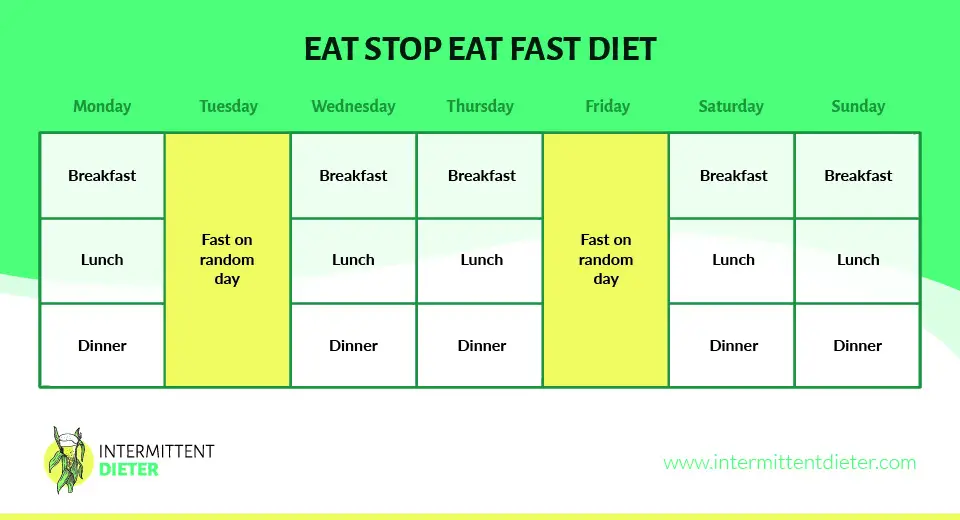
Another branded type of intermittent fasting and another very similar approach to it, developed by Brad Pilon author of the Eat Stop Eat book.
It is also very similar to 4:3 and 5:2 diets, but even less restrictive. The idea is exactly what its name suggests: you decide to fast for one or two days a week, each week.
On non-fasting day, you should not get more than your normal caloric intake, while putting emphasis on eating healthy foods.
But compared to 4:3 and 5:2, the 24h fasting days are strict fasting days. That means if you decide to fast on Monday, you’ll be breaking your fast with dinner for example.
If you eat dinner at 6 pm, on Sunday you should have stopped eating before 6 pm. Not only it’s strict fast, but it’s strict 24 hours fast.
What’s great is that you can still get something to eat on fasting day. And once you broke your fast, you’re free to eat anything you want.
Like the last two aforementioned diets, Eat Stop Eat Fast Diet is putting emphasis on caloric restriction through fasting. Not daily restriction, but weekly.
And Eat Stop Eat will help alleviate all the other benefits of fasting on fasting days: increasing your metabolism, reducing appetite and cravings, etc.
36 Hours Fast
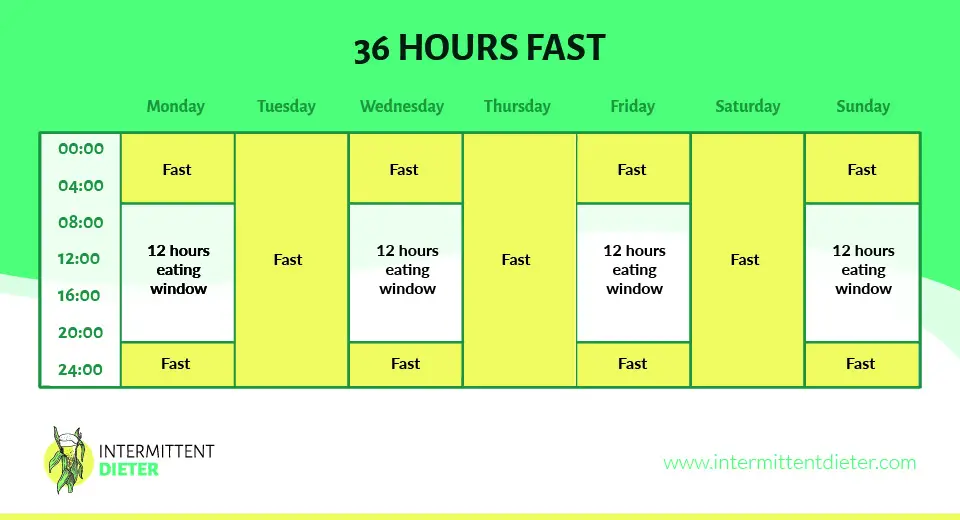
The last step before reaching longer fasts, the 36 hours fast is a type of intermittent fasting that could be used kind of the Eat Stop Eat Fast Diet.
This means if you finished dinner at 8 pm on day one, you will fast for an entire day and then be able to break your fast around 8 am on day three.
This is the hardcore way of doing the last three diets I mentioned. You can implement 36 hours fast in your week pretty much in any way you want, up to three times a week.
One disadvantage of the 36 hours fast, compared to previous ones, would be that if you’re under any kind of medication that you should take every day with food, you’ll be skipping meals too long to take those.
I will talk a bit about prolonged fast, but any fast longer than 24 hours is considered a prolonged fast. I consider 36 hours fast as intermittent fasting because it can still be implemented as an alternate day fast diet.
I couldn’t find studies comparing the effects of fasting after 36 hours when compared to 24 hours. But here’s what basically happens hours by hours with 36 hours fast :
- After around 12 to 14 hours your body will turn to fat stores for energy, ramping up around 16 hours
- After 24 hours, your body will be in ketosis, not full ketosis, that can take several days, but your liver will start producing ketones.
- From 24 to 36 hours, you’ll benefit more from autophagy, which usually kicks in around 24 hours. This means the detox effects of fasting.
Of course, 36 hours vs. 24 hours fast will be more effective for weight loss, it might also alleviate some other benefits of fasting, but I couldn’t find very compelling comparative evidence on the subject.
36 hours fast (and even longer fasts) are sometimes used to treat obese patients or type 2 diabetes in certain specialized clinics. Why 36 hours then? Simply because it is more effective than 24 hours.
You should try 24 hours fast, in any shape that suits you best, before doing 36 hours of course. From experience, it could get difficult not to eat dinner on the fasting day.
You have to weigh in the benefits of doing 36 hours vs. the inconvenience of it. If that’s really hard for you to follow, either because you’re too hungry or because of your social life, don’t push it, any other type of IF is already great.
But if you want faster results and don’t care about these effects, you could try implementing 36 hours fast.
Prolonged fasts
I wanted to talk a bit about longer fasts as an extension of intermittent fasting. Because once you implemented any type of intermittent fasting, once you see it’s not that hard, you might want to push it.
Not in a bad competitive way, but because you’re already able to do something you would have thought to be impossible before, doing longer fasts will suddenly look easier.
And I would advise anybody doing intermittent fasting to try doing longer fasts!
This, of course, comes with a disclaimer: read about it, talk to your doctor about it. Don’t just jump into it, that’ll be putting a lot of stress on your body.
If you try a prolonged fast and feel really unwell or hungry, cut it out. In any case, a prolonged fast should be prepared.
The way you eat and behave before a longer fast is important. Check out my 6 best foods to eat before a prolonged fast as well as the 11 best foods to eat after a fast.
All disclaimer aside, this chapter is not about telling you how to do a prolonged fast, it’s more to encourage you to consider doing longer fasts.
There are many benefits to doing fasting and more so prolonged fasts, but that’s not why I think you should try them.
Not being able to eat for several days, say 5 or 7 days, is really liberating. Sure you might feel bad at first, it’ll be hard on the body and harder on the mind.
It won’t rid you of sugar addiction or bad eating habits, but once you’ve experienced a 5 to 7 kg (14 pounds) weight loss in a week, without gaining much back, that’ll help you put all that diet stuff in perspective.
Like skipping a meal, doing a longer fast is another barrier that, once down, leaves you feeling able to take full control of your weight and your eating habits.
Which One is For You?
None of the types of IF I covered in this article is bad for you. Each one of them will come with its benefits in many aspects of your health. So, just pick one and experiment!
You should evidently start slow, skip meals, then do 12 hours, 16 hours, 18 hours, 20 hours fasts. In a way, these different types can be incremented and combined.
I personally do some type of 16:8 every day, which turns out mostly to be 18:6 because of my eating habits. And once or twice a week I will only eat dinner.
But I have no agenda, I’m not trying to lose weight anymore, I just trying not to gain any. When I randomly skip lunch, it’s often because we didn’t have time to cook something or the fridge’s empty. Or I’m simply not hungry.

Wich one is best for you will highly depend on your habits, social life, what your goals are, etc.
The best IF to keep lean
While any of the intermittent fasting types I mentioned will help keep you lean, I would have to go with the one I use myself: 16:8.
It’s the best compromise between implementing some type of diet and constraints while keeping a normal lifestyle.
It’s easy enough, once you’re able to do it, to make a habit out of it, and easy enough to skip breakfast. 16:8 will make you lose weight and, yes, after a while you might reach a plateau.
But if you’re happy with your weight that’s not a problem. You can still do other types of IF to go to your ideal weight is 16:8 is not enough, and then stick to 16:8 to stay lean.
16:8 will already help you break the first barriers of fasting, it’ll give you some of those benefits such as more energy, focus, better sleep, increased metabolism, reduced hunger, and cravings, etc.
The best IF to lose weight easily
One meal a day to me is the best way to lose weight quickly and easily. Once you’re able to go up to 24 hours without eating, once you’ve done it a few times, you’ll see it gets easier.
And we’re not talking about counting calories, reducing fat or carb intake, weighing what you’re eating. You simply only eat one meal a day.
Do you have lunch with a client? Why not try and only eat lunch instead of dinner for once? Sure, you’ll only be doing around 16 hours fast before lunch, but afterward, you’ll do 30 hours fast until dinner the next day.
What I want to say is that not only it’s effective for weight loss, but it’s also flexible. Being able to do one meal a day will definitely show on the scale, but that doesn’t mean you have to do it every single day at the expense of your lifestyle.
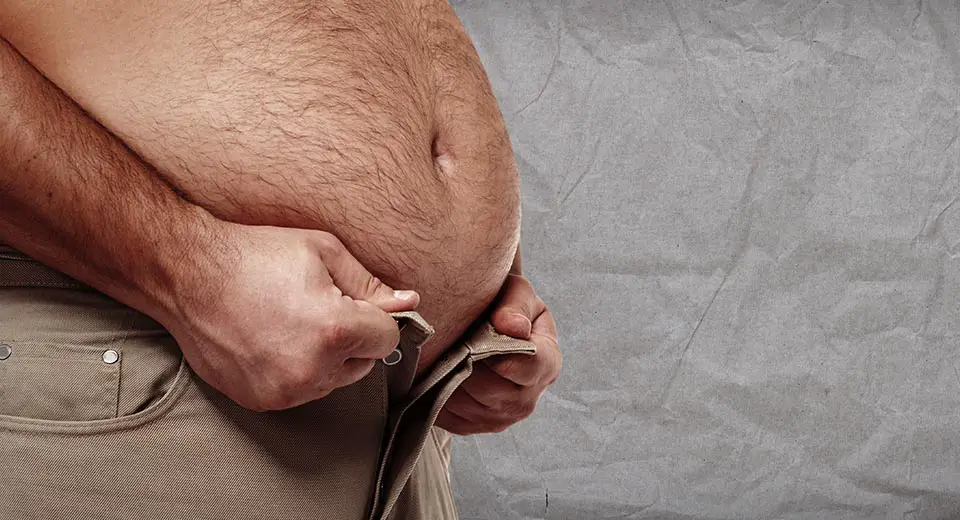
You can’t really screw this up, sure you can eat too much, sure you can have a family reunion and only skip breakfast, sure you can be on vacation and eat 3 times a day for a week.
Don’t sweat it, going you’re not destroying your progress in any way, you can just go back to your ordinary one meal a day habit afterward and, you’ll see, you’ll keep losing some weight and get the health benefits associated with fasting.
If you’re really dedicated, you’ll lose weight faster, that’s all.
Plateau can also happen with OMAD. In case it happens, you could try a prolonged fast, which will make you lose weight and boost your metabolism and confidence, or you could try slightly changing how you eat (reducing carbs for example).
But I would argue there is no easier diet out there to stick to, no diet that’s that flexible, with that much results.
The best IF to lose weight based on studies
As I told you earlier in this article, not all intermittent fasting types have been studied and, even if I’m crazy about OMAD or 16:8, they’re not necessarily those on which we can find the most studies.
Alternate-day fasting, especially 4:3, is the winner in that case, with many studies related to intermittent fasting analyzing this specific eating pattern.
I would argue that if 4:3 works really well, one meal a day might be as effective. 4:3, 5:2 or Eat Stop Eat could be the perfect fit for you and, since I didn’t try any of them, I don’t really know how hard they’re to follow.
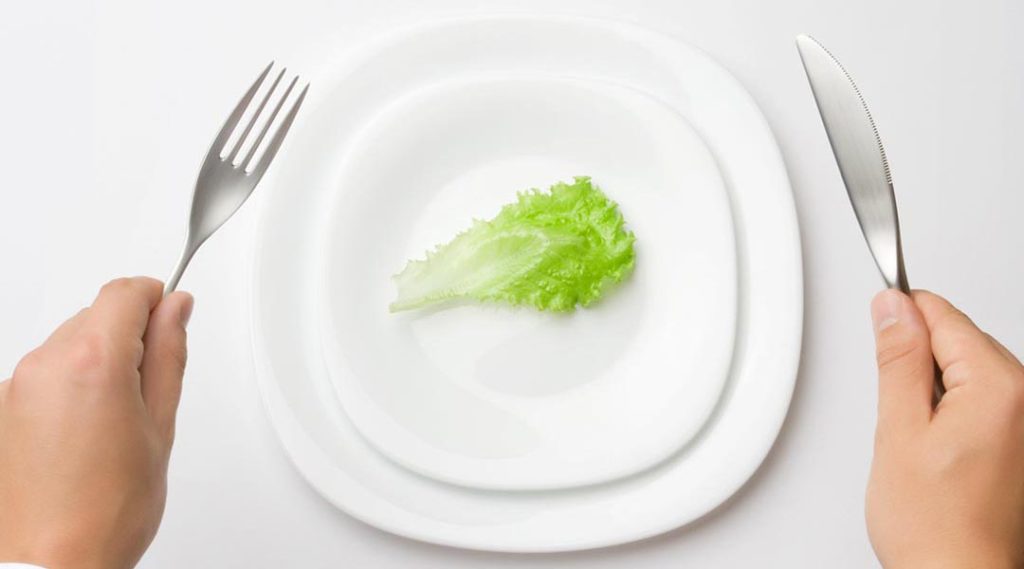
But the 500 calorie day means you might not be able to eat what you want at dinner with friends on a Saturday, eating small amounts can be harder than not eating at all (which you can do if you want) and this pattern seems less easy to create a habit from for me.
Since it’s alternate-day, how will your body react to being used to eat normally one day and almost nothing the next?
Alternate-day fast work and they’re great. If you’re all about science, or if this eating pattern seems right for you, you should definitely try some type of ADF.


